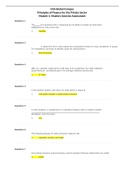FIN 300 (Principles of Finance for the Private Sector)
Colorado State University - Global Campus
Page 2 out of 21 results
Sort by

-
FIN 300: Principles of Finance for the Private Sector - Module 4: Mastery Exercise Assessment (WITH 100% VERIFIED ANSWERS)
- Exam (elaborations) • 5 pages • 2021
- Available in package deal
-
- $12.49
- + learn more
Question 1 The rate of interest actually paid or earned, also called the annual percentage rate (APR), is the interest rate. effective Question 2 Combining two assets having perfectly negatively correlated returns will result in the creation of a portfolio with an overall risk that decreases to a level below that of either asset.

-
FIN 300: Principles of Finance for the Private Sector - Module 3: Mastery Exercise Assessment (WITH 100% VERIFIED ANSWERS)
- Exam (elaborations) • 5 pages • 2021
- Available in package deal
-
- $11.49
- + learn more
Question 1 The statement of cash flows provides a summary of the firm's all of the above. Question 2 A firm has prepared the coming year's pro forma balance sheet resulting in a plug figure in a preliminary statement called "the external financing required "of negative $250,000. The firm may prepare to invest in marketable securities totaling $250,000.

-
FIN 300 Principles of Finance for the Private Sector - Module 2: Mastery Exercise Assessment (WITH 100% VERIFIED ANSWERS)
- Exam (elaborations) • 5 pages • 2021
- Available in package deal
-
- $11.49
- + learn more
Question 1 The of a business firm is measured by its ability to satisfy its short-term obligations as they come due. 1. liquidity Question 2 is where the firm’s ratio values are compared to those of a key competitor or group of competitors, primarily to identify areas for improvement. 1. Benchmarking
The tax rate depends on the level of taxable income. a. true

-
FIN300 - Principles of Finance for the Private Sector: Module 8 Mastery Exercise Assessment Questions and Answers Latest Graded A.
- Exam (elaborations) • 5 pages • 2021
-
- $8.35
- + learn more
Question 1 The problem with a constant-payout-ratio dividend policy from the shareholder's perspective is that if the firm's earnings drop, so does the dividend payment. Question 2 The factors involved in setting a dividend policy include all of the following EXCEPT Operating constraints. Question 3 Stock dividends are costly to issue than cash dividends. more

-
FIN 300 - Principles of Finance for the Private Sector: Module 7 Mastery Exercise Assessment Questions and Answers Latest Graded A.
- Exam (elaborations) • 5 pages • 2021
-
- $8.05
- + learn more
Question 1 A firm has issued preferred stock at its $125 per share par value. The stock will pay a $15 annual dividend. The cost of issuing and selling the stock was $4 per share. The cost of the preferred stock is 12.4 percent. Question 2 In order to recognize the interrelationship between financing and investments, the firm should use when evaluating an investment. the weighted average cost of all financing sources Question 3 The approximate before-tax cost of de...

-
FIN 300 - Principles of Finance for the Private Sector Module 6 Mastery Exercise Assessment Questions and Answers
- Exam (elaborations) • 4 pages • 2021
-
- $8.45
- + learn more
Question 1 Initial cash flows and subsequent operating cash flows for a project are sometimes referred to as relevant cash flows. Question 2 One basic technique used to evaluate after-tax operating cash flows is to add noncash charges to net income. Question 3 Unsophisticated capital budgeting techniques do not explicitly consider the time value of money.

-
FIN300 - Principles of Finance for the Private Sector: Module 4 Mastery Exercise Assessment Questions and Answers Latest Graded A.
- Exam (elaborations) • 5 pages • 2021
-
- $8.85
- + learn more
Question 1 The rate of interest actually paid or earned, also called the annual percentage rate (APR), is the interest rate. effective Question 2 Combining two assets having perfectly negatively correlated returns will result in the creation of a portfolio with an overall risk that decreases to a level below that of either asset. Question 3 Xiao Li wishes to accumulate $50,000 by the end of 10 years by making equal annual end-of- year deposits over the next 10...

-
FIN 300 - Principles of Finance for the Private Sector: Module 3 Mastery Exercise Assessment Questions and Answers Graded A.
- Exam (elaborations) • 5 pages • 2021
-
- $8.95
- + learn more
Question 1 The statement of cash flows provides a summary of the firm's all of the above. Question 2 A firm has prepared the coming year's pro forma balance sheet resulting in a plug figure in a preliminary statement called "the external financing required "of negative $250,000. The firm may prepare to invest in marketable securities totaling $250,000. Question 3 A corporation sold a fixed asset for $100,000. This is an investment cash flow and a source of f...

-
FIN 300 - Principles of Finance for the Private Sector: Module 2 Mastery Exercise Assessment Questions and Answers Latest Version
- Exam (elaborations) • 5 pages • 2021
-
- $8.55
- + learn more
Question 1 The of a business firm is measured by its ability to satisfy its short-term obligations as they come due. 1. liquidity Question 2 is where the firm’s ratio values are compared to those of a key competitor or group of competitors, primarily to identify areas for improvement. 1. Benchmarking Question 3 ABC, Inc. extends credit terms of 45 days to its customers. Its credit collection would likely be considered poor if its average collection period wa...

How much did you already spend on Stuvia? Imagine there are plenty more of you out there paying for study notes, but this time YOU are the seller. Ka-ching! Discover all about earning on Stuvia



